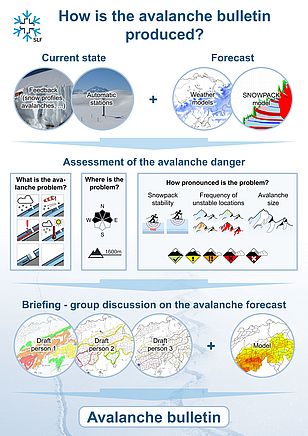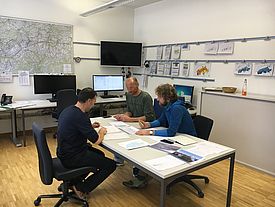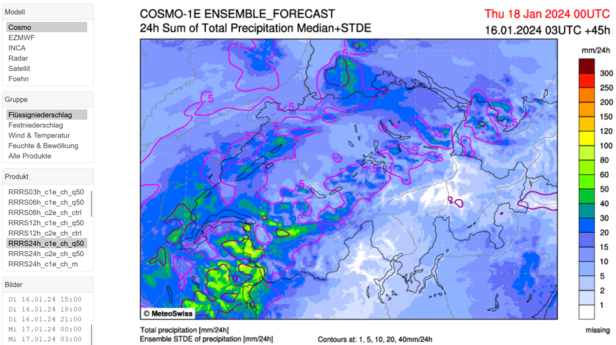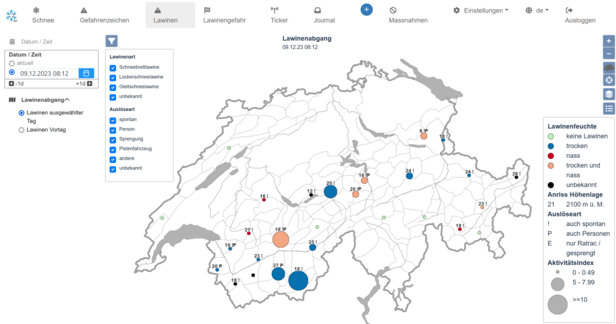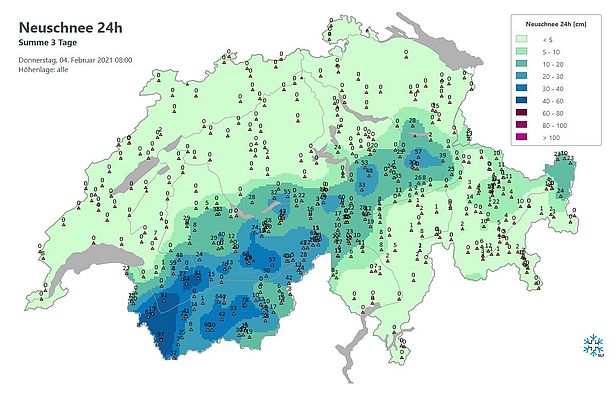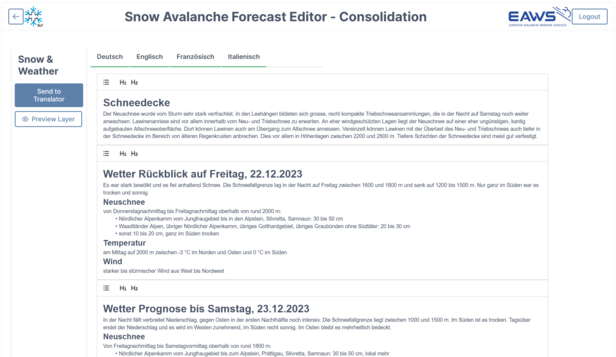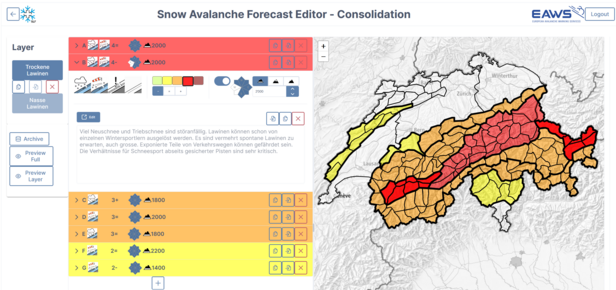The avalanche bulletin is created not at the push of a button, but through teamwork. A duty roster assigns the task of producing the bulletin to alternating groups of three of the eight forecasters in the team. In order to produce a reliable avalanche bulletin, they analyse and interpret a wealth of data and information. The work calls for both expert knowledge and experience.
Summary of key points:
- Avalanche bulletin: Issued by the WSL Institute for Snow and Avalanche Research SLF, the bulletin forecasts the avalanche danger in the Swiss Alps, the Jura and Liechtenstein. It is published once or twice a day in wintertime (at 8 am and 5 pm) and as necessary during the summer. In the winter it consists of a zoomable hazard map with hazard descriptions, as well as an appraisal of the snowpack and weather.
- Data analysis: The forecasters on duty analyse the available measured data, observations and assessments in order to evaluate the current snow and weather situation. For the forecast, they also use weather and snow models.
- The team: There are eight avalanche forecasters working for the SLF. The avalanche bulletin is produced by three of them in turn. The roles within the group of three are “newcomer”, “principal” and “substitute”. When the roster changes, the “newcomer” becomes the “principal”, the “principal” becomes the “substitute”, and the “substitute” drops out of the group on duty. Rotating the forecasters in this way ensures that knowledge concerning recent changes in the snow and avalanche situation is retained and passed on to each group in turn.
- Briefing: At the daily 3 pm briefing, the principal presents the results of his or her analysis. The assessments of the other forecasters are then compared and discussed.
- Software: Special software is needed to produce the avalanche bulletin. The relevant applications are developed by the SLF.
- Distribution channels: The avalanche bulletin is published on the internet and the White Risk app, the Swiss Natural Hazards Portal, as well as on the radio, by way of social media, on television, and in newspapers.
- Mission and funding: The SLF has been responsible for avalanche warning on behalf of the federal government since 1945. While for many years part of the avalanche warning was financed by the Federal Office for the Environment (FOEN), as of 1.1.21 full funding will be provided by the ETH Domain.
Work process
There is a rotation ensuring that three of the eight avalanche forecasters are on avalanche watch duty at all times. Between seasons and when not on duty, they draw up the AvaBlog and winter reports, handle the observer network and accidents, are involved in training, develop new products and perform a variety of research and project work.
How a typical day unfolds ¶
Assessing the avalanche danger is an ongoing process. Producing the next day's forecast already starts before midday the previous day with a detailed analysis of the data. This involves the avalanche forecasters analysing all the information available with programs developed specifically for this purpose. They focus on the factors that have a determining effect on avalanches forming and their likely development in the days ahead. Models with artificial intelligence are also used.
A briefing takes place at 3 pm. At this meeting, the staff from the main shift present the results of their analysis, and then the various avalanche forecasters' assessments are compared and discussed. At the end of the briefing there will be clarity about the snow layering, the most likely weather conditions and, based on this, the expected avalanche situation, including danger levels, particularly affected locations and avalanche problems.
The avalanche forecasters then write up the bulletin and produce the hazard map. Before being sent out, everything is carefully read through and corrected again. At 5 pm every day, the products must be published, so just before this the radio station SRF 1 broadcasts a live interview with the main shift. In the meantime, a translation agency will have translated the German original of the "Snowpack and weather" text into French, Italian and English. The translations are checked by the avalanche forecasters and published by 6 pm at the latest.
The text of the avalanche bulletin concerning „Snowpack and weather“, which has already been written before the briefing by the forecaster on duty, is proofread and edited if necessary. The avalanche forecasters then compose the danger description for each individual danger region. Before being published, everything is carefully read through and corrected again. At 5 pm every day, the products must be published, so just before this the radio station SRF 1 broadcasts a live interview with an avalanche forecaster. In the meantime, a translation agency will have translated the German original of the "Snowpack and weather" text into French, Italian and English. The translations are checked by the avalanche forecasters and published by 6 pm at the latest.
At 5.30 am the next day, the staff from the main shift start working on the next analysis. The focus of their attention here is on unexpected developments during the night, information from observers that does not fit in with the existing picture, and changing weather forecasts that could call for a revision of the previous assessment. The relevant briefing is held at 7 am, and then the adjustments are made and checked. The automatic translation of the danger description means that final changes can be made until immediately before the publication time of 8 am.
Technical systems ¶
A lot more than expert avalanche knowledge and information about developments in terms of snow and the weather is needed to produce the avalanche bulletin twice a day. The SLF's Warning and Information Systems team develops for avalanche warning services tailor-made software solutions that are not available through commercial channels. These include data recording and analysis tools as well as editors required to produce the bulletin, and an interface providing access to the bulletin from the internet and smartphones.
Analysis and visualisation
With around 180 IMIS stations, as well as other MeteoSwiss automated stations, over 200 observers, snowpack and forecast models, meteorological forecasting models and weather reports, there is a huge volume of data which can only be handled appropriately if the values are processed and visualised properly. Global Information System (GIS) technology is used as a basis for the interactive spatial data visualisation. In this context both measurements and observations or assessments can be presented, and statistical values can be calculated.
Bulletin editor ¶
The avalanche bulletin is produced using SAFE, a bulletin editor developed at the SLF and partly in collaboration with the Tyrol Avalanche Warning Service.
This is a text editor used to compile a description of the snowpack and weather information as well as the outlook for the two days following the forecast period. Like all warning products, this part is also checked by a second avalanche forecaster and then immediately sent to the translation agency. This text is translated into Italian, French and English language by a translation agency.
The danger assessment and description are carried out separately for dry avalanches (avalanche problems new snow, wind slabs, old snow and no distinct avalanche problem) and wet avalanches (avalanche problems wet snow and gliding snow). The avalanche forecasters assigns the danger level to each of Switzerland’s more then 140 warning regions and supplement these by inputting the areas particularly affected. Warning regions with a similar avalanche situation are grouped together as 'danger regions' depending on the conditions prevailing at the time. No assessment is made for largely snow-free warning regions.
Catalogue of standard phrases for automatic translation
The avalanche forecasters compile a specific danger description for each danger region. Especially in the mornings, the time frame between the arrival of the observations from the field and the publication time is too limited to produce a manual translation. In this light, a fully automatic translation system was developed at the SLF, which is now used by many avalanche warning services in Europe. It is based on a catalogue of predefined phrases which have already been translated into all the required languages and saved in the database. When producing the bulletin, the danger descriptions are not written freely but made up of these phrases, meaning that they are immediately available in all the relevant languages. To cover every possible situation, the individual phrases do not have a fixed structure. They consist of individual segments, which are selected from various predefined options. Paper on the catalogue of standard phrases: download as a .pdf file
Generating the products and publication ¶
Once the danger assessment and the description have been finalized, the publishing application is used: It reads the dry and wet assessment as well as the text "snow cover and weather" from the database and combines these contents to create the avalanche bulletin. This is made available on an interface to the visualizations on WhiteRisk, but also to external customers. In addition, almost 600 different print products and various special products are created for each bulletin issue.
